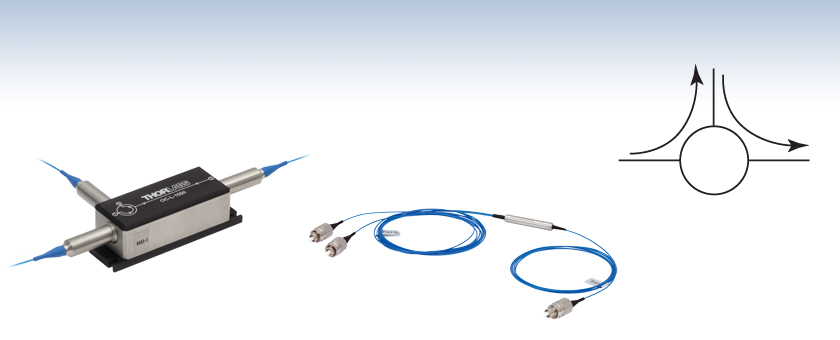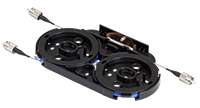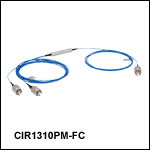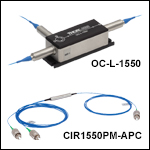Polarization-Maintaining Fiber Optic Circulators

- Non-Reciprocating, Unidirectional Operation
- Center Wavelengths: 1064 nm, 1310 nm, or 1550 nm
- Polarization-Maintaining Fiber Available with Bare Fiber,
FC/PC Connectors, or FC/APC Connectors - Fast Axis Blocking
OC-L-1550
CIR1310PM-FC
Port 2
Port 1
Port 3
Circulator

Please Wait
| Selection Guide for Circulators |
|---|
| SM Circulators |
| 1310 nm SM Circulator for OCT |
| PM Circulators |
| 1064 nm High Power Circulator |
| 1550 nm High Power Circulator |
Features
- Compact Inline Package
- Epoxy-Free Optical Path
- High-Power Options for 1064 and 1550 nm
Applications
- Add-Drop Multiplexing
- Fiber Sensors
- Bidirectional Pumping
- Bidirectional Signal Transmission Systems
- Coupling Inline Chromatic Dispersion Compensation Devices

Click to Enlarge
Figure 1.1 A PM Fiber Circulator Mounted in our BFCT Fiber Component Tray
Thorlabs’ Polarization-Maintaining (PM) Optic Circulators are non-reciprocating, unidirectional, three-port devices that are used in a wide range of optical setups. Available with a center wavelength of 1064, 1310 (O-Band), or 1550 nm (C-Band), these circulators are fast axis blocked and hence are designed to work with light that is launched into the slow axis. Offered are circulators with no connectors, FC/PC connectors, or FC/APC connectors. Thorlabs also offers Single Mode (SM) Fiber Optical Circulators.

Figure 1.2 Circulator used to drop an optical channel from a DWDM system using a Fiber Bragg Grating.
An optical circulator is analogous to an electronic circulator in that both perform similar functions. An optical circulator is a three-port device that allows light to travel in only one direction. A signal entering Port 1 will exit Port 2 with minimal loss, while a signal entering Port 2 will exit Port 3 with minimal loss. Light entering port 2 experiences a large amount of loss at port 1, and light entering port 3 experiences a large amount of loss at ports 2 and 1. Optical circulators are non-reciprocal devices. This means that any changes in the properties of the light caused by passing through the device are not reversed by traveling in the opposite direction.
Because of their high isolation and low insertion loss, optical circulators are widely used in advanced communication systems as add-drop multiplexers, bi-directional pumps, and chromatic dispersion compensation devices.
Figure 1.2 depicts the use of a circulator to drop an optical channel from a DWDM system using a Fiber Bragg Grating (FBG). The input DWDM channels are coupled into Port 1 of the device with a FBG device connected to Port 2. The single wavelength reflected from the FBG then reenters the circulator in port 2 and is routed accordingly to Port 3. The remaining signals pass through the FBG and exit on the top fiber.

Figure 1.3 Circulators can be used to send optical signals through a single fiber in two directions.
Circulators can also be used to send optical signal in two directions down a single fiber. A circulator is located at both ends of the fiber. Each circulator functions to add a signal in one direction while removing the signal in the other. See Figure 1.3.
For custom wavelength and connector options, please contact Technical Support.
| Item # | CIR1064PMa | CIR1310PMa | CIR1550PMa | OC-L-1064 | OC-L-1550 |
|---|---|---|---|---|---|
| Optical Specifications | |||||
| Wavelength Range | 1059 - 1069 nm | 1280 – 1340 nm | 1520 - 1580 nm | 1053 – 1075 nm | 1530 – 1570 nm |
| Insertion Loss | ≤2.1 dB | ≤0.9 dB | ≤0.9 dB | 1.3 – 1.9 dB | 0.9 – 1.3 dB |
| Isolationb | ≥25 dB | ≥40 dB | ≥40 dB | 30 dB | 32 dB |
| Directivity (1-3) | ≥50 dB | ≥50 dB | ≥50 dB | 40 dB | 50 dB |
| Polarization Extinction Ratio | ≥20 dB | ≥22 dB | ≥22 dB | >20 dB | >20 dB |
| Return Loss | ≥50 dB | ≥50 dB | ≥50 dB | 50 dB | 55 db |
| Damage Threshold | 300 mW | 300 mW | 300 mW | 3 W | 5 W |
| Mechanical Specifications | |||||
| Package Dimensions | Ø5.5 mm x 35 mm | 32.6 x 44.5 x 63.5 mmc | 17.8 x 25.1 x 60.3 mmc | ||
| Fiber | SM98-PS-U25D | SM13-PS-U25D | SM15-PS-U25D | PM980-XP PANDA-Style PM Fiber, Hytrel®d Loose Tube, Light in Slow Axis |
PM1550-XP PANDA-Style PM Fiber, Hytrel® Loose Tube, Light in Slow Axis |
| Length | 1.0 +0.075/-0.0 m | 1.2 ± 0.2 m | 1.2 ± 0.2 m | ||
| Operating Temperature | -5 to 70 °C | 10 to 50 °C | 10 to 50 °C | ||
| Storage Temperature | -40 to 85 °C | -10 to 65 °C | -20 to 70 °C | ||
| Operating Relative Humidity | 20% - 80% | ||||
| Storage Relative Humidity | 20% - 80% | ||||
| Posted Comments: | |
Inwoo Park
(posted 2025-10-24 15:32:33.837) Dear sir or meam,
I would like to buy PM optical circulator with shorter length of fiber. In this page, for 1550nm, only 1m length PM fiber circulator is available. It is better that more diverse length of PM fiber circulators are provided.
Or could you let me know there is any way to buy shorter length PM fiber circulator, specifically 0.5m length PM fiber circulator.
Thank you.
Best wishes,
Inwoo Park. EGies
(posted 2025-10-24 01:31:09.0) Thank you for contacting Thorlabs. I have reached out to you directly regarding this custom request. user
(posted 2024-12-04 10:14:44.3) Hello,
My company is interested in exploring fiber optic PM circulators in the visible wavelengths, has Thorlabs performed any product development on this in the past? EGies
(posted 2024-12-23 11:40:41.0) Thank you for contacting Thorlabs. I have added your request to our internal engineering forum for future consideration by our design engineers. I have also reached out to you directly regarding your specific application. Jennifer Lee
(posted 2024-07-31 09:15:51.313) Hi, do you have any magnetic field data on your circulators? We are curious for using these circulators in a magnetically sensitive application and are wondering if it is feasible either as-is or with magnetic shielding. Thanks!
Jen jpolaris
(posted 2024-08-07 07:05:28.0) Thank you for contacting Thorlabs. These polarization-maintaining circulators rely on the Faraday effect to function, and thus would be sensitive to a magnetic environment. If you intend on placing these in a magnetic field, be sure to use adequate magnetic shielding. Petros Gasparyan
(posted 2023-09-09 16:53:00.853) Dear responsible person.
I have a CIR1550PM-FC - PM circulator.
My question is the following.
If I polish my circulator connector with a D50-FC/APC polishing disc, can it be equivalent to the
CIR1550PM-APC - PM circulator.
Thank you in advance. cdolbashian
(posted 2023-09-25 09:59:22.0) Thank you for reaching out to us Petros. Unfortunately, while this makes sense in theory to convert PC->APC, the distinction between these connectors is not a simple difference of the angle, but also a difference in overall length. In this sense, the method you describe would not quite work as intended. user
(posted 2021-05-27 16:57:54.18) I see the damage threshold listed as 300mW or 3W for options that cover 1053nm. I assume this is for CW light. For applications with pulsed light, is the damage threshold for peak power any higher (i.e. a few hundred watts)? cdolbashian
(posted 2021-06-25 08:33:20.0) Thank you for reaching out to us at Thorlabs! The damage threshold and a description of the damage mechanisms at the air-glass interface of a fiber can be found in the "Damage threshold" tab on each individual, non-connectorized, fiber product page. If we have pulse data, we will list it there, although it is usually tested with a 10ns pulse laser. I have contacted you directly regarding your specific inquiry. Alexander Dräbenstedt
(posted 2021-03-09 12:11:57.913) Hello, do these PM-fiber circulators support both polarization directions? Can they be called a "polarization insensitive circulator"? Or do they, for instance, only transmit "slow axis polarization" from port 1 to port 2?
Thanks. asundararaj
(posted 2021-03-09 04:26:45.0) Thank you for contacting Thorlabs. The PM fiber circulators are fast axis blocking and will only support light aligned to the slow axis. For polarization insensitive circulators, we offer the Single Mode fiber circulators, which can then be polarized using a fiber polarization controller if your application requires a polarized output. Yanjing Zhao
(posted 2020-10-14 08:05:55.603) Would you please give me the datasheet of the OC-L-1550 which includes the insertion loss, isolation, etc.? YLohia
(posted 2020-10-14 11:28:10.0) Thank you for contacting Thorlabs. This information is given in the Specs tab on this page. 王 猥
(posted 2020-01-11 20:10:52.603) 你好,我之前在贵公司购买了一个保偏光纤环形器,最近在使用中有些问题。
激光从1口入射,2口不接任何东西,但是在三口能接受到比较强的光信号,不知道这是不是正常的,不知贵公司能不能帮忙检测这个环形器有没有坏。 YLohia
(posted 2020-01-13 09:44:06.0) Thank you for contacting Thorlabs. One of Applications Engineers from our office in China will reach out to you directly regarding this. yoel.sebbag
(posted 2018-10-22 07:48:26.34) Hi,
my name is Yoel Sebbag and I am a Ph.D. student at the Hebrew University of Jerusalem, Israel.
Is it possible to design a custom PM circulator for a wavelength of 780nm with AFC/PC connector?
If yes, how much would it cost?
Thank you very much.
Best regards,
Yoel. YLohia
(posted 2018-10-22 09:18:16.0) Hello Yoel, thank you for contacting Thorlabs. Quotes for custom items can be requested by emailing techsupport@thorlabs.com. I will reach out to you directly to discuss the possibility of offering this. florian.b.bayer
(posted 2018-10-12 13:45:55.95) Could you specify the length of the fibers more clearly? From the specs table I would assume each of the 3 port fibers being 1m long, is this correct? Is there a difference for the version with connectors?
Additionally, what is the reason for the rather large uncertainty of the fiber length, especially in the higher power versions? nbayconich
(posted 2018-10-26 10:13:02.0) Thank you for contacting Thorlabs. That is correct the length indicates the fiber length at each port measured from the circulator housing to either the fiber ferrule or bare fiber end so 1.0 meters long for each fiber for the CIR1064PM circulator. The OC-L-* circulators will all have a +/- 0.2 m tolerance, the design length of the OC-L-1064 IS 1.2 meters ±0.2m while the OC-L-1550 is 2.0 meters ±0.2m.
The uncertainty of the fiber length is given to compensate for the amount of fiber needed to cut in the fiber connector termination process. |

- Center Wavelength 1064 nm
- Polarization-Maintaining Fiber With No Connectors, FC/PC Connectors, or FC/APC Connectors
- Damage Threshold of 300 mW (CIR1064PM) or 3 W (OC-L-1064)
- Fast Axis Blocking
Thorlabs' 1064 nm PM Fiber Optic Circulators are available unterminated, with FC/PC connectors, or with FC/APC connectors. The FC/PC and FC/APC connectors have a 2 mm narrow key. Our OC-L-1064 circulator is a high power circulator with a damage threshold of 3 W.

- Center Wavelength 1310 nm
- Polarization-Maintaining Fiber With No Connectors, FC/PC Connectors, or FC/APC Connectors
- Damage Threshold of 300 mW
- Fast Axis Blocking
Thorlabs' 1310 nm PM Fiber Optic Circulators are available unterminated, with FC/PC connectors, or with FC/APC connectors. The FC/PC and FC/APC connectors have a 2 mm narrow key.

- Center Wavelength 1550 nm
- Polarization-Maintaining Fiber With No Connectors, FC/PC Connectors, or FC/APC Connectors
- Damage Threshold of 300 mW (CIR1550PM) or 5 W (OC-L-1550)
- Fast Axis Blocking
Thorlabs' 1550 nm PM Fiber Optic Circulators are available unterminated, with FC/PC connectors, or with FC/APC connectors. The FC/PC and FC/APC connectors have a 2 mm narrow key. Our OC-L-1550 circulator is a high power circulator with a damage threshold of 5 W.
 Products Home
Products Home














 Zoom
Zoom

 Polarization-Maintaining Fiber Optic Circulators
Polarization-Maintaining Fiber Optic Circulators